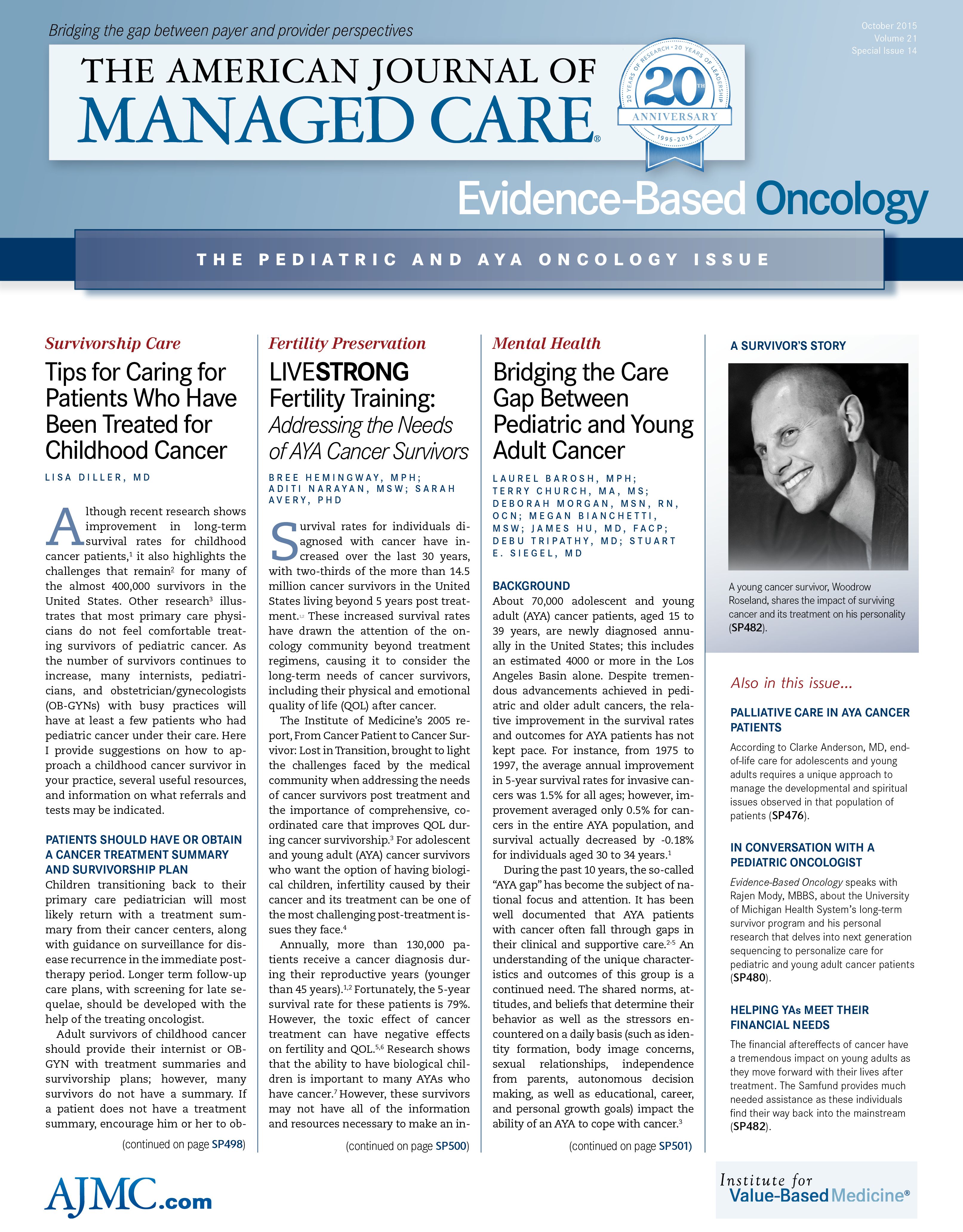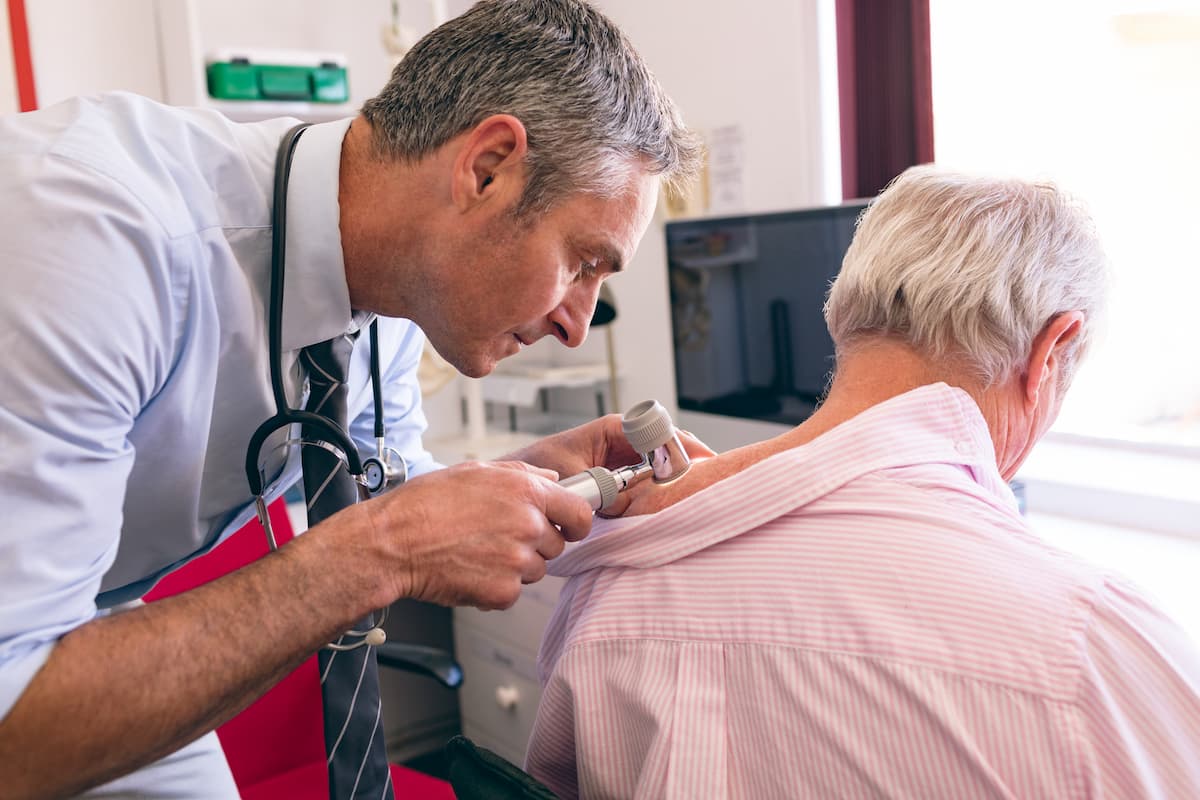Publication
Article
Evidence-Based Oncology
LIVESTRONG Fertility Training: Addressing the Needs of AYA Cancer Survivors
Author(s):
A discussion on the challenges of implementing standards for addressing fertility risks associated with cancer and its treatment and describes an interactive training for healthcare providers to help them overcome challenges to implementation.
Survival rates for individuals diagnosed with cancer have increased over the last 30 years, with two-thirds of the more than 14.5 million cancer survivors in the United States living beyond 5 years post treatment.1,2 These increased survival rates have drawn the attention of the oncology community beyond treatment regimens, causing it to consider the long-term needs of cancer survivors, including their physical and emotional quality of life (QOL) after cancer.
The Institute of Medicine’s 2005 report, From Cancer Patient to Cancer Survivor: Lost in Transition, brought to light the challenges faced by the medical community when addressing the needs of cancer survivors post treatment and the importance of comprehensive, coordinated care that improves QOL during cancer survivorship.3 For adolescent and young adult (AYA) cancer survivors who want the option of having biological children, infertility caused by their cancer and its treatment can be one of the most challenging post-treatment issues they face.4
Annually, more than 130,000 patients receive a cancer diagnosis during their reproductive years (younger than 45 years).1,2 Fortunately, the 5-year survival rate for these patients is 79%. However, the toxic effect of cancer treatment can have negative effects on fertility and QOL.5,6 Research shows that the ability to have biological children is important to many AYAs who have cancer.7 However, these survivors may not have all of the information and resources necessary to make an informed decision related to their fertility and reproductive options, which is associated with increased distress levels in this group. Increased distress levels can affect cancer survivors’ long-term QOL by causing unresolved grief and depression, as well as reduced life satisfaction and increased anxiety.7
Most Frequent Barriers to Fertility Preservation
The disclosure of the risk of iatrogenic infertility, as well as information and referral to fertility preservation services, is often possible for patients prior to, during, and after treatment for cancer.8,9 Although technologies for fertility preservation and reproduction continue to evolve—providing options today that simply did not exist for patients with cancer even a few years ago—significant barriers can prevent patients from receiving this information and the services.9,10 Sometimes doctors fail to disclose the risks of infertility associated with treatment or they fail to refer patients to fertility preservation services; consequently, patients do not seek fertility preservation information or services prior to treatment.11 In addition, due to the urgent need for care, there is often a very short window of opportunity to preserve fertility prior to beginning treatment. Cost is another significant barrier, as fertility preservation is generally not covered by insurance and costs average $8000 for women and $1500 for men to conduct any single fertility preservation procedure. These costs do not include the cost of pre-cycle stimulation medication for women, an average cost of $4500, or annual storage of gametes, which can cost up to $500 a year.9
Support From National Organizations
Addressing fertility concerns has emerged as a major component of cancer care. Numerous organizations have created national standards that express the importance of educating all patients in their reproductive years about the impact of cancer and its treatment on their fertility, including the American Society of Clinical Oncology (ASCO), the National Comprehensive Cancer Network, and the American Society of Reproductive Medicine. In 2006, ASCO issued guidelines outlining the role of oncology healthcare providers in educating their patients about fertility risks and preservation options prior to cancer treatment; the guidelines were updated in 2013.8,12
ASCO’s guidelines call for oncologists to “address the possibility of infertility with patients treated during their reproductive years and be prepared to discuss possible fertility preservation options or refer appropriate and interested patients to reproductive specialists.”8 Despite these guidelines, research continues to indicate that providers are not routinely offering fertility information and referrals to their patients.13,14 A 2011 study found a substantial majority of National Cancer Institute-designated Comprehensive Cancer Centers had no formal procedures to address fertility preservation, nor were they following ASCO’s fertility guidelines.15 Although ASCO’s Quality Oncology Practice Initiative standards offer recommendations on documentation of fertility discussion, researchers have demonstrated that less than 70% of providers document discussions about cancer-related fertility risks and referrals to a specialist. The study results also indicated that providers are less likely to have these discussions with some minority populations and women.11,13
Studies have also shown that there are many barriers to healthcare providers successfully implementing the guidelines, including lack of information about the latest preservation options and communication challenges when engaging in discussions about an often sensitive topic.10 A qualitative study by Knapp and Quinn revealed that in addition to educational barriers, healthcare providers report institutional barriers are a significant hindrance to successfully disclosing risk to patients and making referrals for preservation. For example, despite national guidelines, hospital-level policies do not exist at some institutions regarding fertility guidelines for cancer patients. In addition, healthcare providers cite an extensive case load and the short time available for appointments as barriers to disclosing this information during a visit.10 Healthcare providers require accurate information and support tools to help explain the risk of iatrogenic infertility, fertility preservation procedures, and referral sources in order to effectively educate patients.
An Online Tool for Healthcare Providers
In 2014, the LIVESTRONG Foundation developed an online training program for healthcare professionals to address this need.16 LIVESTRONG Fertility Training for Healthcare Professionals is an interactive online training course designed to engage healthcare professionals as they learn to communicate with patients about fertility risks and family-building options as a result of a cancer diagnosis and its treatment. Additionally, the course provides tools and resources for organizations to establish a systematic approach to fertility at an institutional level.
Since the launch of LIVESTRONG Fertility Training for Healthcare Professionals in January 2015, more than 300 individuals have registered for the training. Most of the registrants identified as a nurse or a nurse practitioner (53%). Most participants (91%) who have responded to the post-training survey have found the training helpful in their work with their patients and indicated that they are more confident in their ability to know how to discuss fertility risks related to a cancer diagnosis or cancer treatment with their patients.
EBO
In addition to fulfilling clinical quality standards, healthcare professionals have a moral imperative to provide patient-centered care that includes addressing cancer-related fertility needs. Numerous studies have captured the information and systemic challenges that physicians and institutions face when implementing the ASCO guidelines on cancer and fertility. The LIVESTRONG Fertility Training course was designed to address these issues. Further research on the outcomes of the LIVESTRONG Fertility Training will help administrators and healthcare educators better understand the effectiveness of online training tools in being a catalyst for practice change among healthcare professionals of AYAs.
Bree Hemingway, MPH, is research and evaluation program manager at the LIVESTRONG Foundation; Aditi Narayan, MSW, is research and evaluation specialist at the LIVESTRONG Foundation; Sarah Arvey, PhD, is research and evaluation director at the LIVESTRONG Foundation.
Corresponding Author
Bree Hemingway, MPH
2201 East 6th Street, Austin, TX 78702
E-mail: bree.hemingway@livestrong.org
Funding Source
EMD Serono is a partner of the LIVESTRONG Fertility program and offers medication at no cost to women that are eligible for the LIVESTRONG Fertility Preservation Discount Program.
References
- SEER stat fact sheets: all cancer sites. National Cancer Institute website. http://seer.cancer.gov/statfacts/html/all.html. Accessed August 31, 2015.
- Cancer facts and statistics. American Cancer Society website. www.cancer.org/docroot/stt/stt_0.asp. Accessed August 31, 2015.
- Hewitt M, Ganz P. From Cancer Patient to Cancer Survivor: Lost in Transition. Washington, DC: National Academies Press; 2005.
- Murphy D, Orgel E, Termuhlen A, Shannon S, Warren K, Quinn GP. Why healthcare providers should focus on the fertility of AYA cancer survivors: it’s not too late! Front Oncol. 2013;3:248.
- Behavioral Risk Factor Surveillance System. Centers for Disease Control and Prevention website. www.cdc.gov/brfss/. Updated August 27, 2015. Accessed August 31, 2015.
- SEER cancer statistics review, 1975-2007. National Cancer Institute website. http://seer.cancer.gov/csr/1975_2007/results_merged/topic_survival.pdf. Accessed August 31, 2015.
- Carter J, Raviv L, Ford JS, et al. A cross-sectional study of the psychosexual impact of cancer-related infertility in women: third-party reproductive assistance. J Cancer Surviv. 2010;4(3):236-246.
- Lee SJ, Schover LR, Partridge AH, et al; American Society of Clinical Oncology. American Society of Clinical Oncology recommendations on fertility preservation in cancer patients. J Clin Oncol. 2006;24(18):2917-2931.
- King L, Quinn G, Vadaparampil S, et al. Oncology nurses' perceptions of barriers to discussion of fertility preservation with patients with cancer. Clin J Oncol Nurs. 2008;12(3):467-476.
- Knapp C, Quinn G. Healthcare provider perspectives on fertility preservation for cancer patients. Cancer Treat Res. 2010;156:391-401.
- Neuss MN, Desch CE, McNiff KK, et al. A process for measuring the quality of cancer care: the Quality Oncology Practice Initiative. J Clin Oncol. 2005;23(25):6233-6239.
- Loren A, Mangu P, Beck L et al; American Society of Clinical Oncology. Fertility preservation for patients with cancer: American Society of Clinical Oncology clinical practice guideline update. J Clin Oncol. 2013;31(19):2500-2510.
- Shnorhavorian M, Harlan L, Smith A et al; AYA HOPE Study Collaborative Group. Fertility preservation knowledge, counseling, and actions among adolescent and young adult patients with cancer: a population-based study [published online July 27, 2015]. Cancer. doi:10.1002/cncr.29328.
- Forman EJ, Anders CK, Behera MA. A nationwide survey of oncologists regarding treatment-related infertility and fertility preservation in female cancer patients. Fertil Steril. 2010;94(5):1652-1656.
- Clayman M, Harper M, Quinn GP, Reinecke J, Shah S. The status of oncofertility resources at NCI-designated comprehensive cancer centers. J Clini Oncol. 2011;29:suppl (abstract 9123).
- LIVESTRONG training. http://train.livestrong.org. Accessed August 31, 2015.






